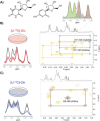Positional Enrichment by Proton Analysis (PEPA): A One-Dimensional 1 H-NMR Approach for 13 C Stable Isotope Tracer Studies in Metabolomics
- PMID: 28220994
- PMCID: PMC5363230
- DOI: 10.1002/anie.201611347
Positional Enrichment by Proton Analysis (PEPA): A One-Dimensional 1 H-NMR Approach for 13 C Stable Isotope Tracer Studies in Metabolomics
Abstract
A novel metabolomics approach for NMR-based stable isotope tracer studies called PEPA is presented, and its performance validated using human cancer cells. PEPA detects the position of carbon label in isotopically enriched metabolites and quantifies fractional enrichment by indirect determination of 13 C-satellite peaks using 1D-1 H-NMR spectra. In comparison with 13 C-NMR, TOCSY and HSQC, PEPA improves sensitivity, accelerates the elucidation of 13 C positions in labeled metabolites and the quantification of the percentage of stable isotope enrichment. Altogether, PEPA provides a novel framework for extending the high-throughput of 1 H-NMR metabolic profiling to stable isotope tracing in metabolomics, facilitating and complementing the information derived from 2D-NMR experiments and expanding the range of isotopically enriched metabolites detected in cellular extracts.
Keywords: NMR spectroscopy; metabolism; metabolomics; stable isotopes.
© 2017 The Authors. Published by Wiley-VCH Verlag GmbH & Co. KGaA.
Figures



References
-
- Stothers J. B., Carbon-13 NMR Spectroscopy, Academic Press, New York, 1972.
Publication types
MeSH terms
Substances
LinkOut - more resources
Full Text Sources
Other Literature Sources
Molecular Biology Databases
Miscellaneous

